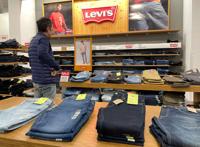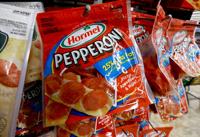New York (CNN) ã Pepperoni was getting out of hand at Hormel.
The food giant last year was selling 71 different versions of its Hormel Pepperoni brand. There was diced pepperoni. Turkey pepperoni. Mini-slices of turkey pepperoni. Pepperoni sticks. Pepperoni with 50% less sodium. Pepperoni with 25% less fat. Thick-sliced pepperoni. The list goes on.
But Hormel is removing, consolidating or repackaging 25% of the items as part of a company-wide strategy to prune unprofitable items across dozens of its brands like Spam, Applegate and Jennie-O, the company said in June. Around 80% of Hormelãs profit comes from a small number of products, like Hormel Bacon and Fire Braised-brand meats, while the rest of its tens of thousands of items often drive up costs and sit untouched in warehouses and on shelves for long periods.
Hormel is reviewing its product lineup to invest in items with higher profit margins, improve lower-performing items and ãremove production complexity,ã a spokesperson for Hormel told CNN.
Thatãs just one example of companies eliminating an endless assortment of products to boost profit. For consumers, it means that they now have fewer choices for everything from sneakers to toys to coffee.
Itãs a reversal of years of companies trying to give customers unlimited choices and shelves getting more and more cluttered with dozens of variations of the same item.
Historically, brands wanted to broaden their choices to gain more shelf space at stores and react to the latest customer trends. But during the beginning of the pandemic in 2020, customer demand skyrocketed and global supply chains ground to a halt. Companies sped up production lines for their primary, top-selling items and ruthlessly pared down their niche offerings, a strategy known as ãSKU rationalization.ã Today, companies are thinning offerings because their sales volumes have dropped after years of raising prices. Food prices have gone up around since 2020.
Since companies no longer can hike prices without pushing away customers, they are turning to cutting clunkers to maintain their profit, said Rob Wilson, a managing director at L.E.K. Consulting who works with brands and retailers.
ãThey canãt raise prices too much anymore, so this is where they go,ã he said. Cutting products boosted companiesã profit margins by 0.9% compared to 2019, L.E.K. Consulting found in a last year.
The more versions a brand offers, the higher their supply chain and distribution costs. With slimmer lineups, companies can narrow their advertising, distribution and sales efforts, focusing investments on a smaller number of items.
Too much mayo
Leviãs, Starbucks, Under Armour, Dollar General, Five Below, Hasbro, Hain Celestial and other companies are cutting down their choices.
Leviãs said in April that it across its portfolio as part of its strategy to sell more clothing directly to consumers through its own stores and websites, a spokesperson told CNN.
Dollar General is taking about 10% of its products off shelves.
ãWe may have five or six different variants of mayonnaise on the shelf today. We can easily drop one or two of those. The consumer is not going to know the difference,ã Dollar General CEO Todd Vasos said last year in an earnings call. The strategy is going to make customersã choices ãa little simplerã and reduce re-stocking work for store employees, he said.
Dollar General did not respond to CNNãs request for comment.
Toy maker Hasbro has slashed around half of its products, which accounted for just 2% of the companyãs revenue.
These products were ãduplicative and unprofitable, clogging the network and creating cost for us and our retailers,ã Hasbro finance chief Gina Goetter said earlier this year. The company, for example, would have a US version of a toy, a European version and a version for Asia, so it cut it down to one across the three regions, a Hasbro spokesperson told CNN.
Companies believe that reducing choices can make it simpler for overwhelmed consumers struggling to decide which type of toothpaste to buy, for example.
ãIn some places, that extra choice doesnãt make sense,ã BJãs Wholesale Club CEO Bob Eddy said last year. ãThere are only so many mint toothpastes you need.ã
Not a sure-fire strategy
But brands cutting too much can backfire.
Companies can upset customers who are loyal to a specific version of a product, pushing them to switch to another brand or storesã private-label versions. Cuts can also create tension with retailers that prefer stocking one version of a product over another.
In 2022, Taco Bell brought back its Mexican Pizza after outrage among fans. An online petition asking for the pizzaãs return garnered nearly 200,000 signatures. Particularly outraged were vegetarians who saw the menu item as one of the few ãfunã meatless options.
ãYou have to apply a scalpel and not a broad axe,ã said David Garfield, a managing director at AlixPartners who works with consumer companies.
One of the most disastrous examples of a company cutting too deep was in 2009, when Walmart pulled thousands of items off its shelves to reduce clutter.
The plan backfired when shoppers could not find their preferred products and abandoned the chain entirely. Walmart added 8,500 items back to its stores two years later with flags saying
ãWeãve listened to our customers and weãre bringing back the products and brands they want,ã the company said in a mea culpa.
The-CNN-Wire
ã & ôˋ 2024 Cable News Network, Inc., a Warner Bros. Discovery Company. All rights reserved.


















